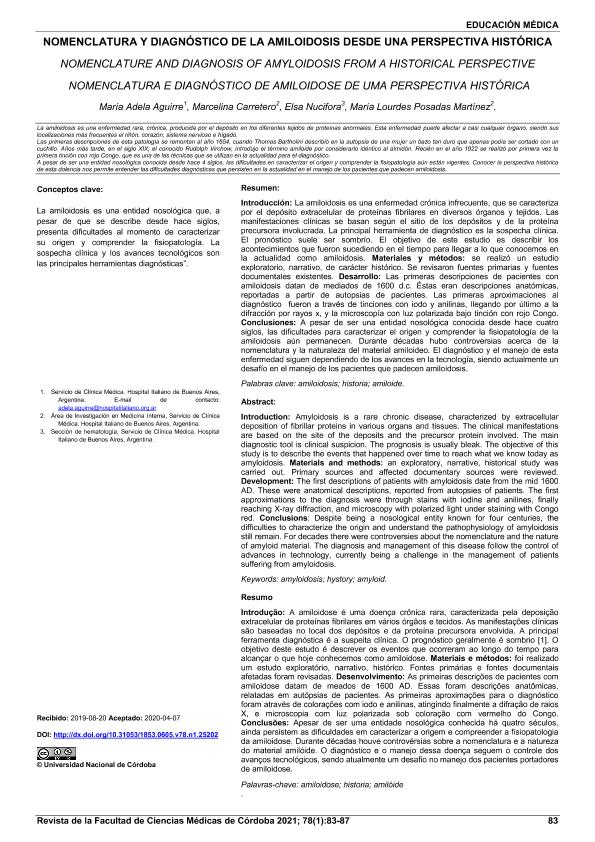Artículo
Introducción: Amyloidosis is a rare chronic disease, characterized by extracellular deposition of fibrillar proteins in various organs and tissues. The clinical manifestations are based on the site of the deposits and the precursor protein involved. The main diagnostic tool is clinical suspicion. The prognosis is usually bleak. The objective of this study is to describe the events that happened over time to reach what we know today as amyloidosis.Materials and methods: an exploratory, narrative, historical study was carried out. Primary sources and affected documentary sources were reviewed. Development: The first descriptions of patients with amyloidosis date from the mid 1600 AD. These were anatomical descriptions, reported from autopsies of patients. The first approximations to the diagnosis were through stains with iodine and anilines, finally reaching X-ray diffraction, and microscopy with polarized light under staining with Congo red.Conclusions: Despite being a nosological entity known for four centuries, the difficulties to characterize the origin and understand the pathophysiology of amyloidosis still remain. For decades there were controversies about the nomenclature and the nature of amyloid material. The diagnosis and management of this disease follow the control of advances in technology, currently being a challenge in the management of patients suffering from amyloidosis.Keywords: amiloidose; history; amilóide. Introduction: Amyloidosis is a rare chronic disease, characterized by extracellular deposition of fibrillar proteins in various organs and tissues. The clinical manifestations are based on the site of the deposits and the precursor protein involved. The main diagnostic tool is clinical suspicion. The prognosis is usually bleak. The objective of this study is to describe the events that happened over time to reach what we know today as amyloidosis. Materials and methods: an exploratory, narrative, historical study was carried out. Primary sources and affected documentary sources were reviewed. Development: The first descriptions of patients with amyloidosis date from the mid 1600 AD. These were anatomical descriptions, reported from autopsies of patients. The first approximations to the diagnosis were through stains with iodine and anilines, finally reaching X-ray diffraction, and microscopy with polarized light under staining with Congo red. Conclusions: Despite being a nosological entity known for four centuries, the difficulties to characterize the origin and understand the pathophysiology of amyloidosis still remain. For decades there were controversies about the nomenclature and the nature of amyloid material. The diagnosis and management of this disease follow the control of advances in technology, currently being a challenge in the management of patients suffering from amyloidosis. Introdução: A amiloidose é uma doença crônica rara, caracterizada pela deposição extracelular de proteínas fibrilares em vários órgãos e tecidos. As manifestações clínicas são baseadas no local dos depósitos e da proteína precursora envolvida. A principal ferramenta diagnóstica é a suspeita clínica. O prognóstico geralmente é sombrio [1]. O objetivo deste estudo é descrever os eventos que ocorreram ao longo do tempo para alcançar o que hoje conhecemos como amiloidose. Materiais e métodos: foi realizado um estudo exploratório, narrativo, histórico. Fontes primárias e fontes documentais afetadas foram revisadas. Desenvolvimento: As primeiras descrições de pacientes com amiloidose datam de meados de 1600 AD. Essas foram descrições anatômicas, relatadas em autópsias de pacientes. As primeiras aproximações para o diagnóstico foram através de colorações com iodo e anilinas, atingindo finalmente a difração de raios X, e microscopia com luz polarizada sob coloração com vermelho do Congo. Conclusões: Apesar de ser uma entidade nosológica conhecida há quatro séculos, ainda persistem as dificuldades em caracterizar a origem e compreender a fisiopatologia da amiloidose. Durante décadas houve controvérsias sobre a nomenclatura e a natureza do material amilóide. O diagnóstico e o manejo dessa doença seguem o controle dos avanços tecnológicos, sendo atualmente um desafio no manejo dos pacientes portadores de amiloidose.
Nomenclatura y diagnóstico de la amiloidosis desde una perspectiva histórica
Título:
Nomenclature and diagnosis of amyloidosis from a historical perspective;
Nomenclatura e diagnóstico de amiloidose de uma perspectiva histórica
Nomenclatura e diagnóstico de amiloidose de uma perspectiva histórica
Fecha de publicación:
03/2021
Editorial:
Universidad Nacional de Córdoba. Facultad de Ciencias Médicas
Revista:
Revista de la Facultad de Ciencias Médicas de Córdoba
ISSN:
0014-6722
Idioma:
Español
Tipo de recurso:
Artículo publicado
Clasificación temática:
Resumen
Palabras clave:
AMILOIDOSIS
Archivos asociados
Licencia
Identificadores
Colecciones
Articulos(SEDE CENTRAL)
Articulos de SEDE CENTRAL
Articulos de SEDE CENTRAL
Citación
Aguirre, Maria Adela; Carretero, Marcelina; Nucifora, Elsa Mercedes; Posadas, María Lourdes; Nomenclatura y diagnóstico de la amiloidosis desde una perspectiva histórica; Universidad Nacional de Córdoba. Facultad de Ciencias Médicas; Revista de la Facultad de Ciencias Médicas de Córdoba; 78; 1; 3-2021; 83-87
Compartir




